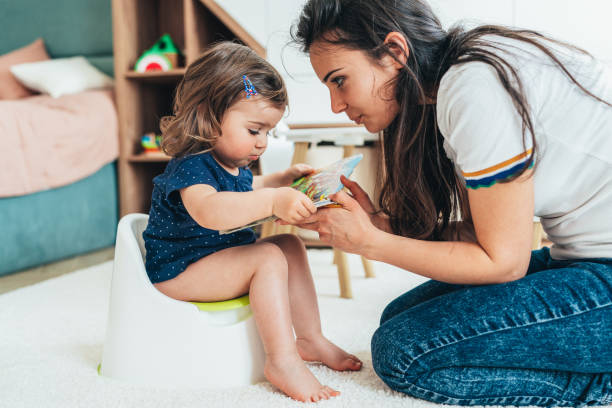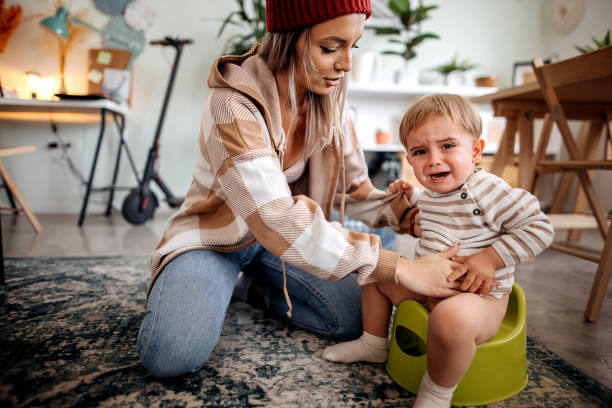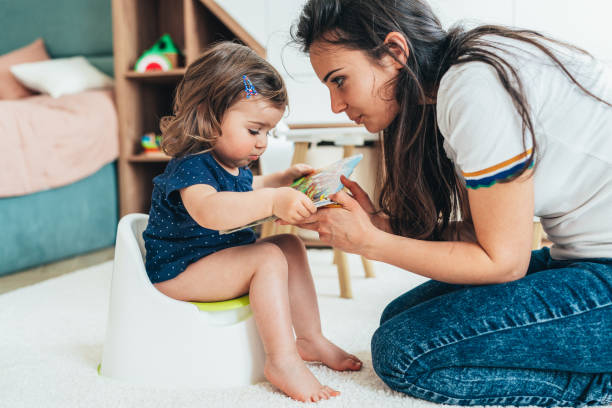Introduction:
Toilet training is a significant milestone in a child's life, marking their transition from diapers to using the toilet independently. As a parenting specialist, I recognize the unique challenges that mothers face when it comes to toilet training their toddlers. In this comprehensive blog, we will delve into the various aspects of toilet training, explore the common problems faced by mothers, and provide effective strategies to navigate this crucial stage successfully. Toilet training is the process of teaching a child to use the toilet for urination and bowel movements, fostering independence and personal hygiene skills. It is an essential step in a child's development, laying the foundation for their self-care abilities and social integration. By mastering toilet training, toddlers gain confidence and a sense of accomplishment while also reducing the burden on parents in terms of diaper changing and associated expenses.
Recognizing the signs of readiness is crucial before embarking on the toilet training journey. These signs include physical cues like increased bladder control, the ability to communicate needs, and cognitive indicators such as understanding and following simple instructions. Identifying these readiness signs is essential to ensure a smoother and more successful toilet training experience. Preparing for toilet training involves creating a positive environment, assembling the necessary tools, and establishing a consistent routine. By fostering a comfortable and supportive atmosphere, children feel encouraged to explore and embrace the new experience. Potty chairs, step stools, and training pants are some of the tools that can aid in the transition process. Additionally, establishing a routine helps children develop a sense of familiarity and predictability, facilitating their understanding and adoption of toilet training concepts.

Different approaches to toilet training exist, and each method has its own advantages and considerations. The gradual approach involves introducing toilet training concepts gradually, allowing children to adjust at their own pace. On the other hand, the intensive approach focuses on concentrated training over a shorter period. Combining these approaches or customizing them to suit individual children's needs can lead to a tailored and effective toilet training experience. However, despite the best efforts and intentions, mothers often encounter common problems during toilet training. Some toddlers may show resistance or refusal to use the toilet, leading to frustration and confusion for both child and parent. Accidents and regression are also common occurrences, where children may have setbacks and temporarily revert to previous behaviors. Additionally, fear and anxiety related to using the toilet can hinder progress and require sensitive handling and support.
Toilet training is a journey that requires consistency, persistence, and effective communication. Through open and clear communication, mothers can help their toddlers understand the process and expectations, fostering a cooperative and engaging environment. Celebrating milestones achieved along the way further reinforces positive behavior and motivates children to continue their progress. By delving into the intricacies of toilet training, addressing common problems, and providing practical tips, this blog aims to equip mothers of toddlers, with the knowledge and guidance they need to navigate this transformative stage successfully. Remember, each child is unique, and the toilet training process may vary, but with the right approach and support, both mother and child can emerge triumphant, embracing newfound independence and accomplishment.
Understanding Toilet Training Basics
Understanding these fundamental aspects of toilet training prepares parents for the journey ahead. By creating a positive environment, assembling the right tools, establishing a routine, and exploring different toilet training methods, mothers can lay a solid foundation for successful toilet training with their toddlers.

Toilet training is a significant milestone in a child's life, and as a parenting specialist, it's crucial to have a comprehensive understanding of the basics. In this section, we will delve into the definition of toilet training, highlight its importance, and discuss the signs of readiness that indicate a child is prepared for this developmental stage.
1.1: Preparing for Toilet Training
Creating a positive and supportive environment is essential when preparing for toilet training. Here, we will explore various aspects that contribute to a conducive atmosphere for successful toilet training.
Creating a Positive Environment: Establishing a positive environment involves ensuring that the child feels safe, comfortable, and encouraged during the toilet training process. By creating a warm and inviting space, such as a dedicated bathroom area, using colorful and engaging materials, and maintaining a calm and encouraging demeanor, parents can help their child feel at ease.
Assembling the Right Tools: Toilet training requires specific tools to assist in the process. Key items include potty chairs, step stools, training pants, and flushable wipes. Choosing the right tools that suit the child's needs and preferences can greatly enhance their toilet training experience.
Establishing a Routine: Consistency plays a vital role in toilet training success. Developing a consistent routine for toilet training sessions helps the child become familiar with the process and establishes expectations. Setting specific times during the day for toilet visits and maintaining regularity in these sessions can provide structure and support for both the child and the parent.
1.2: Introduction to Toilet Training Methods
Toilet training methods can vary depending on individual circumstances and parenting styles. In this sub-section, we will explore different approaches to toilet training and their potential benefits.
The Gradual Approach: The gradual approach involves introducing toilet training concepts gradually over time. This method allows the child to become accustomed to using the toilet at their own pace. It emphasizes building familiarity, reinforcing positive behaviors, and gently guiding the child towards independent toileting.
The Intensive Approach: The intensive approach is a more concentrated and focused method of toilet training. It involves a shorter period of intensive training, where the child receives constant guidance and reinforcement. This method can be beneficial for families seeking faster results or those with specific time constraints.
Combining Approaches: Combining different toilet training approaches can be a flexible and effective strategy. By customizing the approach based on the child's needs and preferences, parents can create a tailored toilet training plan. For example, starting with a gradual approach and incorporating elements of the intensive method when appropriate.
Common Problems Faced by Mothers
By understanding these common problems and implementing effective strategies, you can navigate the challenges of toilet training with greater confidence. Remember, every child is unique, and progress may vary. With patience, consistency, and a positive approach, you can support your toddler through this important developmental milestone.

Toilet training can present several challenges for mothers of toddlers. Understanding and addressing these common problems is crucial for a successful toilet training journey. Let's explore each of these challenges in detail and provide effective strategies to overcome them.
2.1: Dealing with Resistance
It's not uncommon for toddlers to resist or show reluctance towards toilet training. As a mother, it's important to approach this challenge with patience and encouragement. Here are some strategies to help you deal with resistance:
1. Patience and Encouragement: Remain patient and supportive throughout the toilet training process. Encourage your child with positive reinforcement, such as praise or small rewards, to motivate them to use the toilet.
2. Reducing Pressure: Create a stress-free environment by avoiding pressuring your child or setting strict deadlines. Allow them to progress at their own pace and gradually build their confidence.
3. Rewards and Incentives: Consider implementing a reward system where your child earns stickers, small treats, or special privileges for successful toilet usage. This can provide additional motivation and make the process more enjoyable for them.
2.2: Managing Accidents and Regression
Accidents and regression are common occurrences during toilet training. It's essential for mothers to handle these setbacks calmly and supportively. Here are some tips for managing accidents and regression:
1. Staying Calm and Supportive: Reacting calmly to accidents or instances of regression is crucial. Avoid scolding or punishing your child, as it may create negative associations with the toilet. Instead, provide reassurance and remind them that accidents happen and it's part of the learning process.
2. Reinforcement and Consistency: Reinforce positive behaviors by offering praise and rewards for successful toilet usage. Maintain consistency in your approach, even during setbacks, to help your child regain their progress and confidence.
3. Addressing Emotional Needs: Sometimes, accidents or regression can be triggered by emotional or psychological factors. Pay attention to any underlying issues, such as anxiety or stress, and address them accordingly. Offering comfort, reassurance, and open communication can help alleviate emotional barriers.
2.3: Overcoming Fear and Anxiety
Fear and anxiety related to toilet training can significantly hinder progress. It's important to approach these fears sensitively and gradually expose your child to the toilet. Here are some strategies to help overcome fear and anxiety:
1. Gradual Exposure: Introduce your child to the toilet in a step-by-step manner. Start by familiarizing them with the concept, allowing them to sit on the potty chair fully clothed, and then gradually progress to sitting without clothes. This gradual exposure helps them become more comfortable with the toilet.
2. Desensitization Techniques: Utilize storytelling, role-playing, or age-appropriate books and videos that depict positive toilet experiences. These resources can help normalize the process and reduce fears and anxieties.
3. Seeking Professional Help: If fear or anxiety persist or significantly impact your child's well-being, consider seeking professional guidance. Pediatricians, child psychologists, or parenting specialists can provide additional support and tailored strategies to address specific concerns.
Tips for Successful Toilet Training

To ensure a successful toilet training experience for both mothers and toddlers, it's essential to implement effective strategies and follow key tips. Here are some valuable suggestions to guide you through this process:
Consistency and Persistence: Consistency is key when it comes to toilet training. Create a consistent routine by taking your child to the bathroom at regular intervals, especially after meals and naps. Be persistent in your efforts, even if there are setbacks or initial resistance. With time and consistency, your child will develop a better understanding of the process.
Communication and Language: Effective communication plays a vital role in toilet training. Use simple and clear language to explain the purpose of the toilet and encourage your child to communicate their needs. Teach them relevant words or phrases to express when they need to use the bathroom. Additionally, praise and encourage open communication throughout the process.
Celebrating Milestones: Celebrating your child's achievements and milestones during toilet training can boost their confidence and motivation. Whether it's successfully using the potty, having fewer accidents, or even just showing enthusiasm for the process, acknowledge and celebrate these moments. Offer praise, rewards, or small incentives to reinforce positive behavior and keep them engaged.
Creating a Supportive Environment: Make the bathroom a welcoming and child-friendly space. Consider using colorful and engaging decorations, such as bath toys or child-friendly toilet seat covers. Ensure the bathroom is well-lit and easily accessible to your child. Additionally, make sure the toilet and potty chair are clean and comfortable, ensuring a positive experience for your little one.
Positive Reinforcement: Positive reinforcement is a powerful tool during toilet training. Offer praise, hugs, and verbal affirmations when your child makes progress or successfully uses the toilet. Consider using a sticker chart or reward system, where they can earn stickers or small rewards for each milestone achieved. This positive reinforcement helps motivate your child and encourages continued success.
Patience and Understanding: Patience is crucial during toilet training. Understand that accidents and setbacks are a normal part of the process. Respond with patience and understanding, avoiding frustration or punishment. Instead, gently redirect your child to the bathroom, calmly clean up accidents, and reinforce the importance of using the toilet.
Modeling and Imitation: Children learn by observing and imitating others, so be a positive role model. Let your child observe you or other family members using the toilet, explaining the process and its significance. This helps them understand that toilet training is a natural part of growing up.
Flexibility and Individuality: Every child is unique, and their readiness and progress in toilet training may vary. Be flexible and adapt to your child's needs and pace. Avoid comparing their progress to other children or feeling pressured by external expectations. Respect your child's individuality and support their development at their own pace.
Conclusion:
Toilet training is a significant milestone in a child's development, and it can present unique challenges for mothers, particularly with toddlers. Throughout this blog, we have explored the various aspects of toilet training, including its definition, importance, readiness signs, preparation, methods, and common problems faced by mothers. It is crucial for mothers to create a positive environment and assemble the right tools for toilet training. By establishing a routine and choosing an appropriate method, such as the gradual approach or intensive approach, mothers can tailor their approach to their child's needs.
However, it is common for mothers to encounter challenges during the toilet training process. Resistance, accidents, regression, fear, and anxiety are all potential hurdles. The key is to approach these obstacles with patience, encouragement, and support. By reducing pressure, providing positive reinforcement, and addressing emotional needs, mothers can help their child overcome these challenges and continue making progress. Consistency and persistence are essential throughout the toilet training journey. Effective communication and language play a significant role in guiding the child and understanding their cues. Celebrating milestones achieved during toilet training boosts the child's confidence and motivates them to continue their progress.
In conclusion, toilet training requires a patient and positive approach from mothers. By understanding the basics, addressing common problems, and implementing effective strategies, mothers can navigate this important stage with confidence. Remember that every child is unique, and the timing and methods may vary. By supporting their child's development through successful toilet training, mothers can lay the foundation for their child's future independence and personal hygiene habits.

